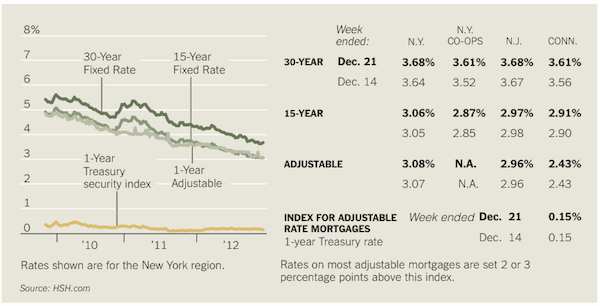Mortgages
To Givers of Down Payments
By LISA PREVOST
Published: December 27, 2012 
HOME buyers trying to scrape together enough money to cover the typical 20 percent down payment frequently look to relatives for help.
In a National Association of Realtors survey of people who bought homes from July 2011 to June 2012, about a quarter of first-time buyers relied in part on gifts from relatives. “Typically, that’s the Bank of Mom and Dad,†said Walter Molony, a spokesman for the association.
But mortgage lenders closely scrutinize cash gifts. That critical check from the parents may not count toward your home purchase if you can’t thoroughly document its source and intention.
“Basically, the banks want to make sure that you’re not getting a second loan,†said Ray Mignone of the New York financial planning firm Ray Mignone & Associates. “If all of a sudden $50,000 pops into your account, they want to make sure it’s not a loan against the property that they’re going to put a mortgage on.â€
How to pass muster with the lender? First, it’s best if the gift comes from a close relative.
“It can’t be a friend or colleague, “ said Ace Watanasuparp, the president of DE Capital Mortgage, in New York. “And it can’t be your second cousin or something like that.â€
Next, make sure that the gift comes in the form of a check or wire transfer — something traceable. Lenders are typically wary of gifts made in cash, Mr. Watanasuparp said.
The donor will also have to provide the lender with what is known as a gift letter.
Melissa L. Cohn, the chief executive of Manhattan Mortgage, said the gift letter should affirm that the money involved is indeed a gift from the donor and, more important, that repayment is not required. The donor should also specify the precise amount of the gift, and state his or her relationship to the borrower.
For good measure, Ms. Cohn added, donors should provide proof of their ability to give the gift — for instance, evidence of a stock sale, or a statement showing the withdrawal. Once the money is in the borrower’s account, the lender may also want to see proof of a deposit in the exact amount stated in the gift letter.
Just how heavily a borrower may rely on family largess to cover a down payment depends on the type of mortgage involved and the size of the gift. With a conventional loan, lenders require that borrowers contribute at least 5 percent of their own money. But this minimum does not apply if the borrower is getting a gift that amounts to 20 percent or more of the home purchase price, Ms. Cohn said.
Borrowers using a loan from the Federal Housing Administration may use gifts to cover their entire down payment.
Mr. Mignone advises prospective buyers to deposit any monetary gifts into their account a few months before seeking a mortgage. That way, he said, the bank is less likely to question them.
As for would-be donors, before writing a check, they should consider their liability under federal gift tax regulations. Individual gifts of $13,000 or less are exempt from the tax. This may sound like a low ceiling, but the gift allowed for is larger than it appears. For example, if two parents want to give money to their newlywed daughter, each may give $13,000 to the daughter, and $13,000 to her partner, for a nontaxable total of $52,000.
Donors can spread more cheer into the next year — and double the amount to the same couple, to $104,000 — by timing the gifts for December and January.
“Write each check separately,†Mr. Mignone said. “Don’t lump them together.â€
Gifts that exceed the $13,000 threshold are supposed to be reported to the Internal Revenue Service. Your lifetime gift total is applied toward any exclusion allowed under the estate tax after your death. Lending institutions aren’t responsible for reporting large gifts, but individual donors are. And while it might seem easy to skirt this requirement, Mr. Mignone doesn’t advise it. “It’s like anything with the I.R.S.,†he said. “If you get audited, you’d better have done it.â€
Source: http://www.nytimes.com/2012/12/30/realestate/mortgages-to-givers-of-down-payments.html
Published by